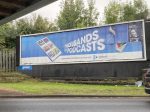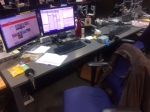In which I offer some useful readings about the art and practice of journalism and why it matters.

I’ll ask about whether small-scale radio stations can get an idea of how many people are listening without having to shell out a shed-load of cash to an audience research company.
I’ll consider whether voice-over artists have a future (“Terms and conditions apply. The value of your investment could go down. See in-store for details. Your home could be at risk if you…” and so on).

I’ll also have a review of my latest book, as well as more news and reaction to the BBC’s Digital First strategy.
But first, something caught my eye that’d been posted by a journalist working for the Corporation.
James Waterhouse, from early 2022, has been the BBC’s correspondent in Ukraine. In this recent clip he shares an example of what he calls a “DJ”.
He explains that in TV jargon it’s a “Dynamic Junction”. It’s intended to go out in the run up to the top of the hour. I’d like to know what you think. Watch this.
I’d think of it as a “trail ahead” as well. It’s an interesting piece of very watchable TV journalism. I wonder: does it produce a visual stimulant designed to entertain? Or does it – in the space of only a few seconds – make you want to keep watching for more info?
Let me know in the comment box below. Extra points if you can argue that TV news presents a simulacrum. A gold star if you can also include the name Jean Baudrillard in your answer.
So much for James Waterhouse’s telly version of the DJ. My work has so far been about the radio version of the acronym.

I’m interested in the cultural effects of listening to the radio and how creatives have used the wireless as a “symbol”. Before you get worried, I mention just two French intellectuals in my book and neither is Baudrillard.
Instead I’ve been sifting through the songs, novels, films and TV shows that’ve been inspired by radio.
For example, “The Last DJ”, and “Hang the DJ” both feature in my latest book. Putting Tom Petty, Morrissey and Johnny Marr in the same sentence is an interesting move…
There’s also mentions for Clint Eastwood and Robin Williams who’ve both played screen DJs.

My fellow union member Adam Christie was kind enough to write a review of my book Radio’s Legacy in Popular Culture. Adam and I are both members of the Leeds branch of the National Union of Journalists.
This appeared in the branch’s magazine. The piece is © Adam Christie, 2024, and is posted with permission. For information, e-mail: adam_christie@journalist.com
On another aspect of radio, I – like a number of broadcast colleagues – give my time to volunteer at my local community radio station. Operations like this are run mostly by a couple of paid staff and the goodwill of around 100 volunteers who each give a few hours of their time to make programmes, record interviews and present live shows.

I’ve always lived and died (so to speak) by the quarterly joint audience surveys of BBC and commercial radio stations. But spare a thought for the small FM outfits run by volunteers. And particularly community-based ones who just can’t afford the annual fees to join RAJAR, the UK’s audience research outfit for radio.
Well, I found this next item on the web. And it could be a way to guestimate audience size. Here’s the thing: if you’re considering how to measure your radio station’s FM engagement then try working with the figures you get from your streaming service. That could help to build in some factor which may be a useful way to get a certain kind of measure. Like this quote says, if you use this “method” do make your assumptions clear.
One way to estimate broadcast listenership is to take your webcast hours and scale it by the “online-to-broadcast” ratio measured in RAJAR surveys. It’s something like 21%:79%. As long as you state the assumptions used it’s as valid as other methods.
Let me warn you that just because I’ve published this quote it doesn’t mean such advice is accurate, or trustworthy.

To change topic, and artificial intelligence (AI) has been a subject of comment for almost two years, since late 2022. I’ve resisted joining the general mêlée of half-conjectured prediction as to whether it means the end of humanity, our jobs, and the rise of I, Robot etc.
But I was taken by this recent really well-made video from The Economist (with the support of one of the well-known legal firms in the British media world…). The bit towards the end about the future rôle for voice-over artists is a little bit worrying because of its closeness to home…
And in the wake of last year’s Digital First changes to BBC Local Radio, here’s news of one of the shows from BBC Radio Solent that’s found a new home. https://radiotoday.co.uk/2024/01/bbc-local-radio-specialist-music-show-stereo-underground-to-leave-the-bbc/
And good news north of London: https://radiotoday.co.uk/2024/01/former-bbc-three-counties-radio-presenter-mike-naylor-returns-with-mix-92-6/
Back to the matter of audience figures, and this analysis from February 2024 is by Matt Deegan. As he quite rightly says half-way down his article, it’s just a little bit too early to judge the BBC’s Digital First pivot, and its effect on audience numbers and reach.
https://onaudio.mattdeegan.com/p/rajar-q42023

Meanwhile, David Lloyd, who I’ve mentioned previously here and here, has questioned the extent of the public consultation responses in 2023 to the BBC Digital First initiative. Read here.
https://www.davidlloydradio.com/post/ofcom-says-it-s-all-fine
And in February 2024 Sally Pepper, formerly of BBC Radio Derby – where I started my staff career with the Beeb – shared her thoughts. https://www.derbytelegraph.co.uk/news/derby-news/former-bbc-radio-derby-dj-9079417
Then a few days later, also in February, the BBC announced plans for the expansion of radio services. https://www.bbc.co.uk/mediacentre/2024/plans-digital-music-stations-extensions-bbc-radio-1-bbc-radio-2-bbc-radio-3
Which provoked a swift response from the commercial radio sector in the UK. They were less than pleased:
You can also follow the story about the programme changes and redundancies in BBC Local Radio in my previous articles. Aug ’23, Sept ’23, Oct ’23, Nov ’23, Dec ’23 and Jan ’24.

And finally, a thing my students at Uni often seemed to dislike: the annotated bibliography. That was a task I’d set to encourage them to read a book or two, and to show evidence that they’d done it.
The resulting document is, hopefully, a list of sources, with some brief notes about each one. It shouldn’t be just a rehash of the blurb on the back of the book, but at least that would show me they’d been to the library and got it down from the shelf – or looked at the last page of the online version.
So, let me share this resource. This is from the Oxford Uni Reuters Institute for the Study of Journalism. If I was marking it, I’d suggest they need to include a line or two describing each reading. But fair dos, it’s a very comprehensive list and an essential resource. Enjoy.
https://reutersinstitute.politics.ox.ac.uk/selection-readings-journalism-journalists
At some stage I’ll offer an annotated list of my readings on FM radio. If you’ve got a favourite book about radio you’d like to share, drop me a comment.
Thanks Martin, engaging as ever! here’s one of my favourite pieces of ‘taster’ audio & video- the BBC news 24 one minute countdown – full of drama.
LikeLike